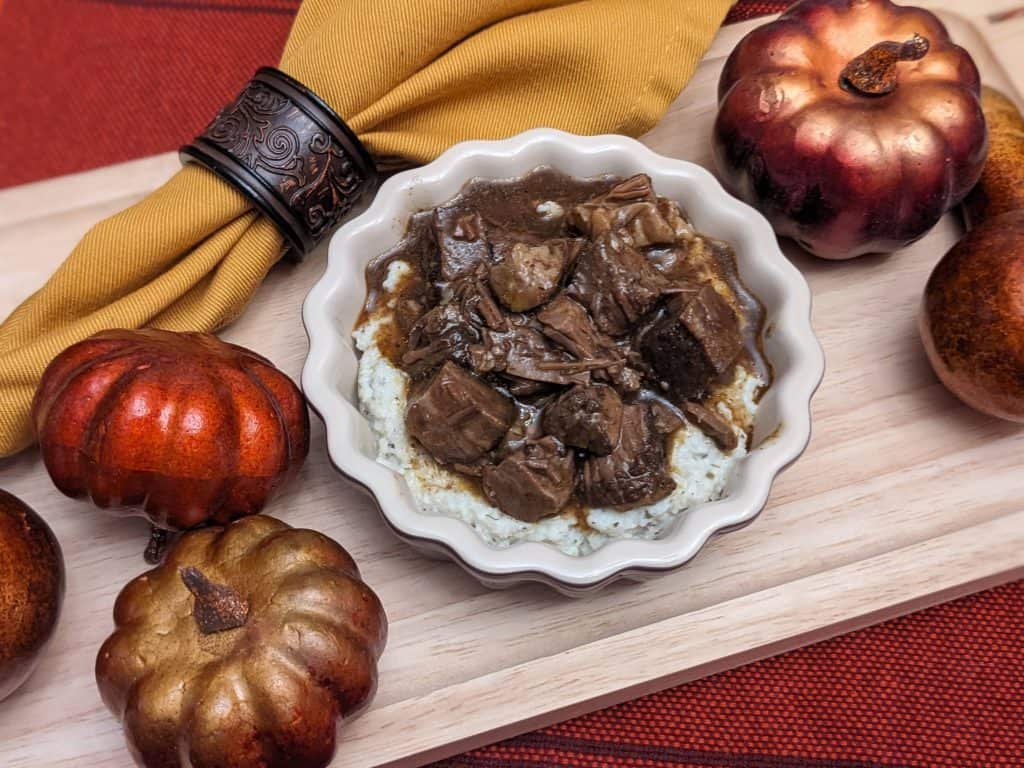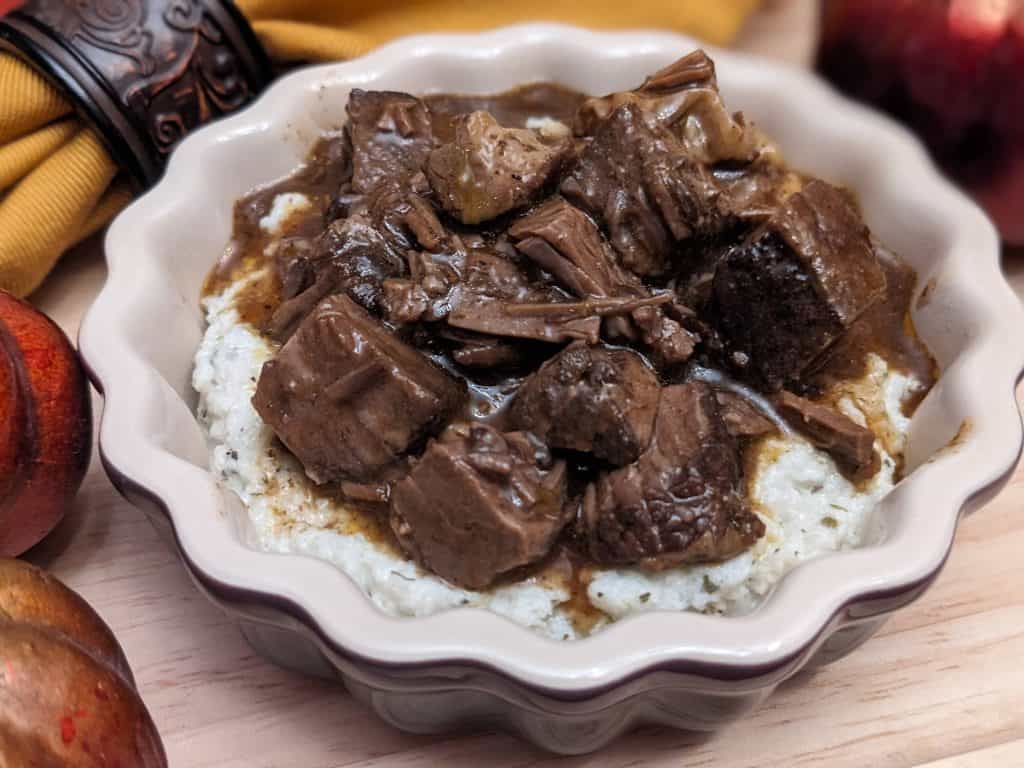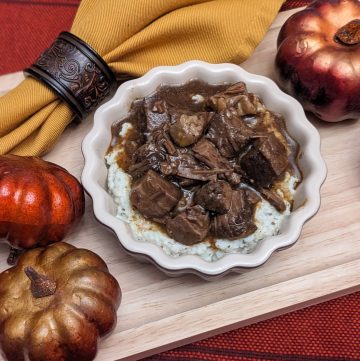With a smooth and decadent sauce that you could practically drink and tender beef that just about falls apart, what’s not to love about this Braised Beef in Wine Reduction Sauce. The second best part (after the flavor, that is)? It can be used for any number of beef roast cuts giving you some added flexibility.

Sometimes you are at the mercy of whatever cut(s) of beef are available at the grocery store on a given day. Other times, I get a cut of beef from our CSA and wonder what to do with it. For those types of situations, I wanted a recipe that I could turn to and know that it will be tasty. I originally used this recipe when I made Beef Short Ribs and it was a hit every time. This led me to wonder: was it the short ribs or the recipe that was so yummy? So I decided to do some testing. I adapted it to any random cut of beef I came across, the cheaper the better. I had to do a bit of fiddling mostly related to surface area for the rub, but that was pretty straightforward.
While I will not claim that this is a fast recipe, I will tell you that it is easy to stage and great to prepare in advance and then just heat and serve. In fact, it’s really best that way so that flavors have time to settle and meld. That makes it great for a dinner party because it means you have very little to do for this dish on the day of your dinner. Give it a try!
What You Need to Make Braised Beef in Wine Reduction Sauce
Equipment
- Cutting Board
- Chef’s Knife
- Measuring Cups
- Measuring Spoons
- Rimmed Baking Sheet
- Heavy Duty Aluminum Foil
- Paper Towels
- Rubber Scraper
- Dutch Oven – Only if you are not using an Instant Pot. If no Dutch Oven, then a large pot.
- Tongs
- 2 Airtight Container – For chilling the cooked beef and the juice for the sauce.
- Fine Mesh Sieve – For straining the Ham Stock.
- Large Bowl – For capturing the strained Ham Stock.
- Gravy Separator (Optional) – This is for removing the fat / oil layer from the juice before making the wine reduction sauce. Alternatively, you can chill the juice so that the fat / oil solidifies on top and then just remove the solid disk. Or you can skim it off the top with a spoon (less ideal).
- Large Saucepan
- Whisk
- 9×13-inch Casserole Dish
Ingredients
- For the Dry Rub:
- Swerve Brown – You could also use another brown sugar substitute such as Sukrin Gold
- Paprika – You can use either sweet or smoked paprika.
- Curry Powder – You can use sweet, hot, or mild depending on your preference. I’ve used each of them for this recipe.
- Ground Cumin
- Ground Black Pepper
- Kosher Salt
- Ground Mustard
- For Cooking the Beef:
- Avocado Oil – This is just for searing the beef and softening the onions a bit. You could also use another high smoke point oil like Regular Olive Oil.
- Beef Roast – You can pick any roast cut. I suggest without bone unless you’re using short ribs. In that case, bone-in is fine, but be aware of the weight difference.
- Onions – You can just cut these in large chunks. No need for finer chopping.
- Garlic – You can use whole cloves (peeled) if you prefer. I keep minced garlic on hand at all times so that is what I use.
- Red Wine – You need 1 normal size bottle for this. I usually use a Pinot Noir for this recipe but have also used a Cabernet Sauvignon in the past. I like pinot for it, since I think of the cooking liquid and aromatics as Burgundian-style.
- Beef Broth – You could also use chicken stock or a mixed meat stock if that’s what you have. I prefer beef for this recipe, but sometimes that’s just not what’s available.
- Fresh Rosemary
- Bay Leaves
- For the Wine Reduction Sauce:
- Xanthan Gum – Although you’ll reduce the sauce, it still needs a little bit of help from the xanthan gum to thicken up.
Getting Started with Making Braised Beef in Wine Reduction Sauce
I know this one can look a tad daunting, so we’re going to break it down into the following stages:
- Making the Dry Rub
- Prepping the Beef
- Searing, Deglazing, and Braising
- Chilling
- Making the Wine Reduction Sauce
- Reheating and Serving
You can space out each of these stages / steps leading up to suit your time budget. The part for which you do need to plan a chunk of time is the “Searing, Deglazing, Braising” step. That all needs to go together and is about a 4.5 hour chunk of time (mostly inactive).
Making the Dry Rub
This part is easy. We’re just going to combine ½ cup Swerve Brown, 1.5 tablespoons Paprika, 1 tablespoon Curry Powder, 1 tablespoon Ground Cumin, 1 tablespoon Ground Black Pepper, 1 tablespoon Kosher Salt, and 1.5 teaspoons Dry Mustard. We can just mix everything well and then set it aside.
Prepping the Beef
Now we need to get the dry rub all over as much of the beef as possible.
First, you need to pat the 6 pounds Beef Roast dry with paper towels. Then we’re going to cut the roast into large pieces about 2” x 2” x 4”. It doesn’t have to be exact. We’re going for chunks that are still fairly large but provide more surface area for the dry rub than if you had kept the roast whole.
To make cleanup easier, I suggest lining a rimmed baking sheet with aluminum foil and using that as your work surface for applying the dry rub. We’ll massage the dry rub into all sides of the roast chunks. You will not use all of the rub right now. Save the remainder to add to the pot before braising. We’ll set the rub-coated meat on a plate and place it in the fridge, uncovered, for at least 1 hour.
Searing, Deglazing, and Braising
When you’re ready to cook, you’ll need to preheat the oven to 250°F.
Then, in a Dutch Oven (see Recipe Notes for Alternatives to using a Dutch Oven), you need to heat 2 – 3 tablespoons of Avocado Oil and sear the Beef chunks on all sides (including the ends). Once seared, you’ll remove the seared meat to a plate on the side. You may need to work in batches to prevent overcrowding the pan.
Adding more Avocado Oil if needed, next you’ll sauté the onion chunks for about 3 minutes. Then you add 1 tablespoon Garlic and cook it for another 30 seconds. You will deglaze immediately with 750 mL Red Wine.
After that, you just need to add the Beef back into the pan along with the remaining spices from the Dry Rub, 3 sprigs Fresh Rosemary, 3 Bay Leaves, and 6 cups Beef Broth (or as much as it takes to come just to the very top of the meat). You’ll cover and move the Dutch Oven to the oven and braise it at 250°F for 4 hours.
Crockpot Alternative Cooking
You could also cook this in your crockpot on high for 4 – 5 hours or low for 8 – 10 hours.
Chilling
After the 4 hours is up, you want to remove the vessel from the oven and take off the lid. Using tongs, you need to remove the Beef chunks to a container like a casserole dish with a lid and allow it to cool. Then we move the meat to the fridge for at least 2 hours to chill.
Once the liquid in the braising dish is cool enough to handle, you need to strain it through a fine mesh sieve into a large bowl. You can discard everything that was strained out of the liquid.
Now for the fun part. We need to remove the layer of fat / oil from the top of the liquid by any method you prefer. If time permits, I recommend chilling the liquid until the fat forms a solid disk on the top, which can be easily removed. Should you not have time for that, then suggestion number 2 is to use a gravy separator if you have one. In the event that neither of those will work, you can use a ladle or large spoon to remove the fat / oil from the top.
Making the Wine Reduction Sauce
Next we’re on to making the Wine Reduction Sauce. We’ll do so by pouring the remaining liquid into a large saucepan over medium high heat. Then we cook down the liquid until it is reduced by about half. Stir occasionally to prevent any sticking or burning on the bottom. This usually takes me about 30 minutes.
Once the liquid is reduced, we need to start whisking vigorously while we add ½ teaspoon Xanthan Gum. You need to keep whisking until it is completely dissolved and the sauce coats the back of a spoon. Then you can remove the sauce from heat, where it will continue to thicken a bit.
Reheating and Serving
Now that all of the flavors have had time to get to know each other, we’re ready to reheat and serve the dish.
We’ll start this last step by taking the beef out the fridge and cutting it into ~1.5 inch cubes. Then we’ll place the cubes in a 9×13-inch casserole dish and pour the Wine Reduction Sauce over them. To reheat them, we just cover the dish with aluminum foil and put it in the oven at 180°F for 20 minutes.
Serve warm. You might want to serve it over a tasty gorgonzola cauliflower mash or something like that.

Related Recipes
Looking for some ideas of what to serve with this Braised Beef in Wine Reduction Sauce?
- This would be great with my Creamy Cauliflower Rice Risotto.
- Or check out my Friendsgiving Food Ideas for more suggestions.
Interested in some other beef dishes? You might like my Beef Roast with Tomato, Cumin, and Feta.

Braised Beef in Wine Reduction Sauce
Ingredients
For the Dry Rub:
- ½ cup Swerve Brown Or Sukrin Gold or other brown sugar substitute of your choice
- 1.5 tablespoons Paprika Either sweet or smoked
- 1 tablespoon Curry Powder Sweet, hot, or mild depending on your preference
- 1 tablespoon Ground Cumin
- 1 tablespoon Ground Black Pepper
- 1 tablespoon Kosher Salt
- 1.5 teaspoons Ground Mustard
For Cooking the Beef:
- 6 pounds Beef Roast any cut without bone
- 2 – 4 tablespoons Avocado Oil Plus more as needed. Or another high smoke point oil like Regular Olive Oil.
- 1.5 Onions Cut in large chunks.
- 1 tablespoon Garlic Minced. About 6 cloves.
- 750 milliliters Red Wine 1 bottle. I usually use a Pinot Noir.
- 3 sprigs Fresh Rosemary
- 3 Bay Leaves
- 6 cups Beef Broth You may need slightly less, but the idea is for the liquid to come just to the very top of the meat.
For the Wine Reduction Sauce:
- ½ teaspoon Xanthan Gum
Instructions
For Making the Dry Rub:
- Combine ½ cup Swerve Brown, 1.5 tablespoons Paprika, 1 tablespoon Curry Powder, 1 tablespoon Ground Cumin, 1 tablespoon Ground Black Pepper, 1 tablespoon Kosher Salt, and 1.5 teaspoons Ground Mustard.½ cup Swerve Brown, 1.5 tablespoons Paprika, 1 tablespoon Curry Powder, 1 tablespoon Ground Cumin, 1 tablespoon Ground Black Pepper, 1 tablespoon Kosher Salt, 1.5 teaspoons Ground Mustard
- Mix well and set it aside.
For Cooking the Beef:
- Pat the 6 pounds Beef Roast dry with paper towels. Cut the roast into large pieces about 2” x 2” x 4”. It doesn’t have to be exact, but you’re going for chunks that are large but provide more surface area for the dry rub than if you kept the roast whole.6 pounds Beef Roast
- Line a rimmed baking sheet with aluminum foil to make a work surface for yourself. Massage the dry rub into all sides of the roast chunks. You will not use all of the rub. Save the remainder to add to the pot before braising. Set the rub-coated meat on a plate and place it in the fridge, uncovered, for 1 hour.
- Preheat the oven to 250°F.
- Heat 2 – 3 tablespoons Avocado Oil in a Dutch oven (see Recipe Notes for Alternatives to using a Dutch Oven). Sear the Beef chunks on all sides (including the ends). Remove the seared meat to a plate on the side. You may need to work in batches to prevent overcrowding the pan.2 – 4 tablespoons Avocado Oil
- Adding more Avocado Oil if needed, sauté 1.5 Onions (in large chunks) for about 3 minutes. Then add 1 tablespoon Garlic and cook for another 30 seconds. Deglaze immediately with 750 milliliters Red Wine.1.5 Onions, 1 tablespoon Garlic, 750 milliliters Red Wine
- Add the Beef back into the pan along with the remaining spices from the Dry Rub, 3 sprigs Fresh Rosemary, 3 Bay Leaves, and 6 cups Beef Broth (or as much as it takes to come just to the very top of the meat).6 cups Beef Broth, 3 sprigs Fresh Rosemary, 3 Bay Leaves
- Cover and move the Dutch Oven to the oven. Braise at 250°F for 4 hours.
- Remove from the oven and take the lid off the dish. Using tongs, remove the Beef chunks to a container like a casserole dish with lid and allow to cool. Then move to the fridge for at least 2 hours to chill.
To Make the Wine Reduction Sauce:
- Once the liquid in the braising dish is cool enough to handle, strain it through a fine mesh sieve into a large bowl. Discard everything that was strained out of the liquid.
- Remove the layer of fat / oil from the top of the liquid by any method you prefer. If time permits, chill the liquid until the fat forms a solid disk on the top that is easily removed. If not and you have one, use a gravy separator. If you don’t have the time or a gravy separator, you can use a ladle or large spoon to remove the fat / oil from the top.
- Pour the remaining liquid into a large saucepan over medium high heat. Cook down the liquid until it is reduced by about half. Stir occasionally to prevent any sticking or burning on the bottom.
- Once it’s reduced, start whisking while adding ½ teaspoon Xanthan Gum. Keep whisking until it is completely dissolved and the sauce coats the back of a spoon. Remove from heat. It will continue to thicken a bit.½ teaspoon Xanthan Gum
To Heat and Serve:
- Remove the chilled Beef from the fridge and cut it into ~1.5-inch cubes. Place the cubes in a 9×13-inch casserole dish. Pour the Wine Reduction Sauce over the Beef cubes.
- Cover with aluminum foil and place in the oven at 180°F for 20 minutes.
- Serve warm. Perhaps over a tasty gorgonzola cauliflower mash.
Equipment
- Measuring Cups
- Measuring Spoons
- Heavy Duty Aluminum Foil
- Paper Towels
- Dutch Oven Only if you are not using an Instant Pot. If no Dutch Oven, then a large pot.
- Airtight Container
- Fine Mesh Strainer or Sieve For straining the Ham Stock.
- Large Bowl For capturing the strained Ham Stock.
- Gravy Separator Optional
- Large Saucepan
- Whisk
Notes
- Alternatives to Cooking the Beef in a Dutch Oven
- Other Braising Vessel in Oven
- While a Dutch Oven is ideal for this recipe because it easily goes from stove top to oven and is a good vessel for braising, no worries if you don’t have one.
- In that case, you’ll want to use a large sauté pan or skillet on the stove and then transfer everything to a deep oven safe casserole dish with a lid for the long, low braise.
- Use the large sauté pan for searing the beef, sautéing the onion and garlic, and deglazing with the wine.
- After the deglazing step, you can move the everything to the deep braising vessel and then pour in the Beef Broth.
- Cover the braising / casserole dish with the lid and stick in the oven, following the same instructions as with the Dutch oven. If you don’t have a lid for the dish, use Heavy Duty Aluminum Foil secured very tightly over the top.
- Crock-Pot
- Follow the same searing and deglazing steps as listed above.
- Then instead of putting it in a braising vessel in the oven, place it in the crock-pot. I would suggest no smaller than a 6-quart crock-pot.
- Cook on High for 4 – 5 hours or Low for 8 – 10 hours.
- Other Braising Vessel in Oven


Leave a Reply